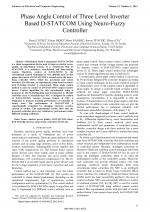| 1/2012 - 13 |
Phase Angle Control of Three Level Inverter Based D-STATCOM Using Neuro-Fuzzy ControllerCOTELI, R. |
| View the paper record and citations in |
| Click to see author's profile in |
| Download PDF |
Author keywords
electric power quality, D-STATCOM, three-level H-bridge inverter, neuro-fuzzy controller, MATLAB
References keywords
power(18), statcom(15), control(15), electronics(10), system(6), static(6), fuzzy(6), controller(6), voltage(5), iecon(5)
Blue keywords are present in both the references section and the paper title.
About this article
Date of Publication: 2012-02-28
Volume 12, Issue 1, Year 2012, On page(s): 77 - 84
ISSN: 1582-7445, e-ISSN: 1844-7600
Digital Object Identifier: 10.4316/AECE.2012.01013
Web of Science Accession Number: 000301075000013
SCOPUS ID: 84860724702
Abstract
Distribution Static Compensator (D-STATCOM) is a shunt compensation device used to improve electric power quality in distribution systems. It is well-known that D-STATCOM is a nonlinear, semi-defined and time-varying system. Therefore, control of D-STATCOM by the conventional control techniques is very difficult task. In this paper, the control of D-STATCOM is carried out by the neuro-fuzzy controller (NFC) which has non-linear and robust structure. For this aim, an experimental setup based on three-level H-bridge inverter is constructed. Phase angle control method is used for control of D-STATCOM's output reactive power. Control algorithm for this experimental setup is prepared in MATLAB/Simulink and downloaded to DS1103 controller card. A Mamdani type NFC is designed for control of D-STATCOM's reactive current. Output of NFC is integrated to increase tracking performance of controller in steady state. The performance of D-STATCOM is experimentally evaluated by changing reference reactive current as on-line. The experimental results show that the proposed controller gives very satisfactory performance under different loading conditions. |
| References | | | Cited By |
Web of Science® Times Cited: 9 [View]
View record in Web of Science® [View]
View Related Records® [View]
Updated today
SCOPUS® Times Cited: 11
View record in SCOPUS® [Free preview]
View citations in SCOPUS® [Free preview]
[1] Applications of neuro fuzzy systems: A brief review and future outline, Kar, Samarjit, Das, Sujit, Ghosh, Pijush Kanti, Applied Soft Computing, ISSN 1568-4946, Issue , 2014.
Digital Object Identifier: 10.1016/j.asoc.2013.10.014 [CrossRef]
[2] INFGMN – Incremental Neuro-Fuzzy Gaussian mixture network, Mazzutti, Tiago, Roisenberg, Mauro, de Freitas Filho, Paulo José, Expert Systems with Applications, ISSN 0957-4174, Issue , 2017.
Digital Object Identifier: 10.1016/j.eswa.2017.07.032 [CrossRef]
[3] Performance analysis of SRFT based D-STATCOM for power quality improvement in distribution system under different loading conditions, Sirohi, Vijay, Saggu, Tejinder Singh, Singh, Mandeep, International Journal of Emerging Electric Power Systems, ISSN 2194-5756, Issue 0, Volume 0, 2023.
Digital Object Identifier: 10.1515/ijeeps-2023-0107 [CrossRef]
Disclaimer: All information displayed above was retrieved by using remote connections to respective databases. For the best user experience, we update all data by using background processes, and use caches in order to reduce the load on the servers we retrieve the information from. As we have no control on the availability of the database servers and sometimes the Internet connectivity may be affected, we do not guarantee the information is correct or complete. For the most accurate data, please always consult the database sites directly. Some external links require authentication or an institutional subscription.
Web of Science® is a registered trademark of Clarivate Analytics, Scopus® is a registered trademark of Elsevier B.V., other product names, company names, brand names, trademarks and logos are the property of their respective owners.
Faculty of Electrical Engineering and Computer Science
Stefan cel Mare University of Suceava, Romania
All rights reserved: Advances in Electrical and Computer Engineering is a registered trademark of the Stefan cel Mare University of Suceava. No part of this publication may be reproduced, stored in a retrieval system, photocopied, recorded or archived, without the written permission from the Editor. When authors submit their papers for publication, they agree that the copyright for their article be transferred to the Faculty of Electrical Engineering and Computer Science, Stefan cel Mare University of Suceava, Romania, if and only if the articles are accepted for publication. The copyright covers the exclusive rights to reproduce and distribute the article, including reprints and translations.
Permission for other use: The copyright owner's consent does not extend to copying for general distribution, for promotion, for creating new works, or for resale. Specific written permission must be obtained from the Editor for such copying. Direct linking to files hosted on this website is strictly prohibited.
Disclaimer: Whilst every effort is made by the publishers and editorial board to see that no inaccurate or misleading data, opinions or statements appear in this journal, they wish to make it clear that all information and opinions formulated in the articles, as well as linguistic accuracy, are the sole responsibility of the author.





